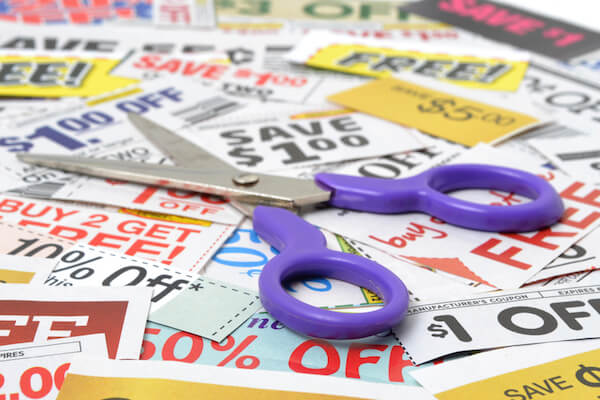Happy National Coupon Month!
Whether you knew it before or not, September is a big month in the couponing industry, meant to spread awareness (and increase deals) right before the busy holiday season. Since you’re on Living Rich With Coupon’s site, I am going to assume I don’t need to convince you of the value that couponing can bring to both your budget and your life. However, as a savvy couponer, are you aware of just how “on trend” you are? Do you even know where the concept of couponing came from and why it is so big today?
I didn’t think so. So, ladies and gentlemen, let me tell you a story.
The Early Years
To shoppers in the 21st century, saving money with coupons is a given, but this wasn’t always so. In fact, the modern concept of coupons really only traces back to the middle of the 20th century, even though the origins of the practice are set nearly a century beforehand…
Let’s go back to Atlanta in the year 1886. A pharmacist by the name of John Pemberton has just come up with a formula for a new type of soft drink ans is selling it for just 5 cents a glass. While clearly a deal, Pemberton was a pharmacist, not a marketer, and needed an easy way to reach out to those who would enjoy his new treat. Thus, Pemberton and his bookkeeper came up with a plan. They handed out vouchers on the streets of Atlanta. Each entitled itsholder to a free glass of Pemberton’s new beverage. Yet, while he gained some followers in the area, unfortunately, even this effort failed.
Then, in 1888, Pemberton sold his recipe, along with his marketing strategy to a man named Asa Candler for the hefty sum of $2,300. He liked Pemberton’s plan, but decided it needed a broader reach. So, after Candler printed up the same vouchers, he inserted them into magazines and mailed them across the country. A few short years later, Coca-Cola became a household name, one that still offers willing consumers a good deal if they find the right coupon.
20th Century Precedents
As I mentioned before, Pemberton, Candler, and Coca-Cola only represent the origins of the couponing industry as we know it today. In the 20th century, Candler’s plan multiplied as more retailers embraced the powerful marketing message that a well-placed coupon could send. In 1909, C.W. Post Grape Nuts cereal changed the game once again by offering the first “cents off” coupon, offering users one penny off retail price of the product. During the Great Depression, the need to save money by any means possible further propelled the coupon industry forward, as more households embraced the practice.
It was not until 1957, however, when the Nielsen Coupon Clearing Company completely reset the game. In their own words, they were “responding to demand” by giving retailers a central hub for coupon operations. This move and The Nielsen Company firmly established something that no couponer today would dare to deny: we are here to stay.
Coupons Today
In the 21st century coupon use once again changed dramatically as more and more people use them and in more and more ways. In fact, in 2015 the industry reported that more than $321 billion worth of manufacturer coupons were printed and distributed in the United States. These coupons applied to both food and non-food purchases. Furthermore, coupon in general continues to rise, after hitting its record low in 2006 – notably before the Great Recession that started many of us on this couponing journey.
Here are some other interesting facts and figures about coupons in America today:
- Despite stereotypes to the contrary, Millennials are some of the most loyal and committed couponers. Not only do some 96% report coupon use over the past year, a 2015 eMarketer survey found that 47% of Millennial used more coupons that year.
- Load-to-Card (L2C) coupons have seen tremendous growth over the past few years, with usership up 19.2% between 2014 and 2015. Even more amazing, over the last four years, use of L2C coupons has risen a staggering 373%.
- eMarketer estimates that 57.5% of all internet users over age 18 will redeem a digital coupon this year.
- 73% of all holiday purchases are influenced by coupons and sales.
- Couponing is not just for the low-income. Among affluent households, or those making more than $100,000 per year, some 90% report at least some coupon use. Even more amazing is the fact that 28% of people in this actually plan to increase their coupon use over the next year.
Coupons in the Future
While the statistics above are certainly encouraging for those of us who love coupons, there is another element to the couponing industry directly linked to the modern era and the digital coupon movement. Clearly, digital is the way of the future and, in fact, digital coupon use grew 5.2% last year. However, the demand for this type of couponing option and supply is currently incredibly unbalanced. According to David Mounts, Chairman and CEO of Inmar, whose extensive research into modern commerce and coupons specifically, the future of coupons will depend a lot on the willingness of companies to keep up with the times.
As shoppers expect more personalized engagement and demand easier ways to shop and save, marketers must adopt more effective means for delivering discounts to them and earning their business. [Yet,] the coupon redemption trends we’re seeing indicate that the strategies currently deployed are not yet aligning with consumer demand and media use — leaving shoppers unable to find coupons for the products they want to buy.
With National Coupon Month in full swing, let’s hope retailers hear that cry and provide shoppers and coupon enthusiasts alike with the savings they want on the products they love. Who knows, doing so may make them the next Coca-Cola.

